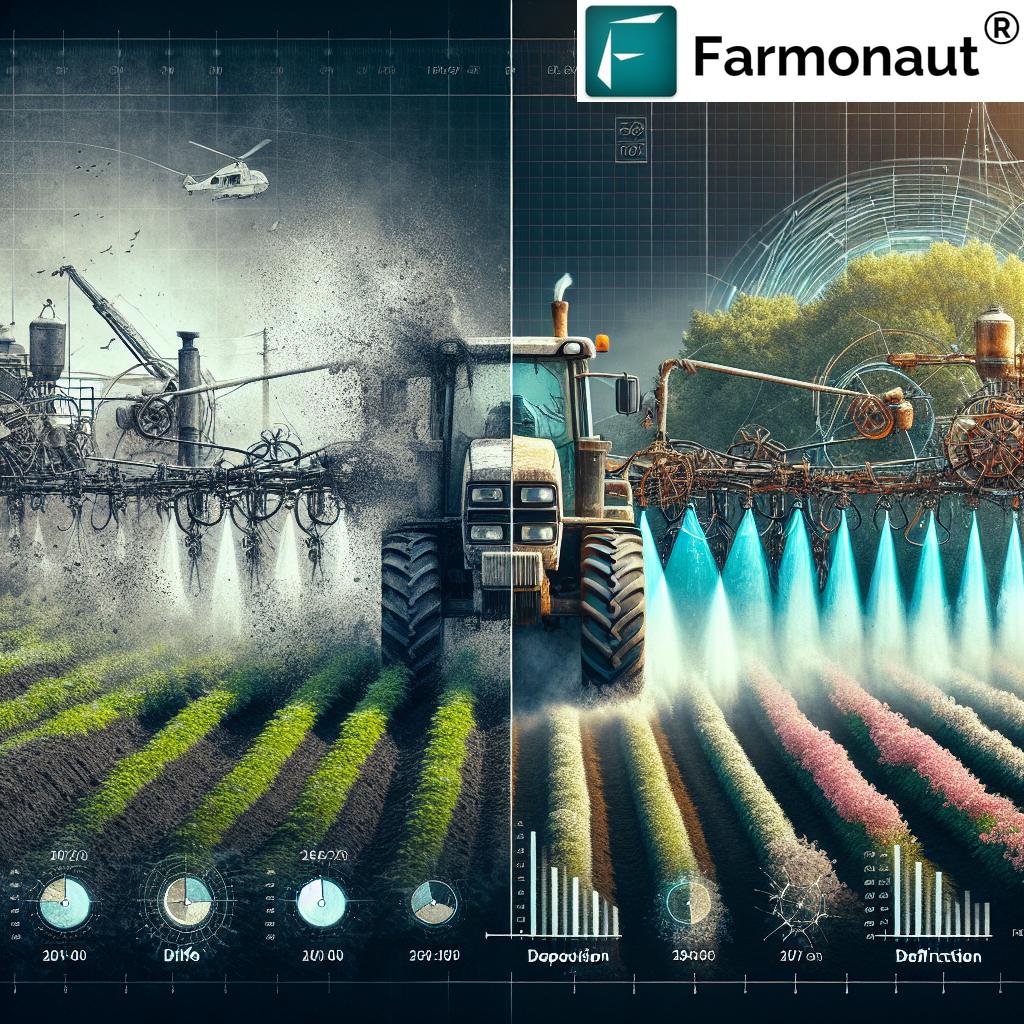Revolutionizing Australian Agriculture: Sustainable Spray Drift Management for Profitable and Eco-Friendly Grain Farming
“Australian grain farmers using precision agriculture technology can reduce chemical drift by up to 75% in buffer zones.”
Welcome to our comprehensive guide on sustainable spray drift management in Australian grain farming. At Farmonaut, we’re committed to revolutionizing agriculture through innovative precision technology and sustainable practices. In this blog post, we’ll explore how our cutting-edge solutions are transforming the landscape of grain farming in Australia, enhancing both profitability and environmental stewardship.

The Importance of Sustainable Spray Drift Management
Spray drift management is a critical aspect of modern agriculture, particularly in the vast grain fields of Australia. As we strive for more sustainable and efficient farming practices, it’s essential to address the challenges posed by agricultural chemical application. Effective spray drift management not only protects the environment and neighboring crops but also ensures optimal use of resources, leading to increased profitability for growers.
At Farmonaut, we understand the delicate balance between maximizing crop yields and minimizing environmental impact. Our precision agriculture technology is designed to help Australian grain farmers achieve this balance through innovative spray management techniques and tools.
Precision Agriculture: The Key to Sustainable Farming
Precision agriculture is at the heart of sustainable spray drift management. By leveraging advanced technologies such as satellite imagery, artificial intelligence, and data analytics, we’re able to provide farmers with unprecedented insights into their fields and crops. This level of detail allows for more precise and targeted application of agricultural chemicals, significantly reducing the risk of spray drift.
- Real-time crop health monitoring
- AI-driven advisory systems
- Weather pattern analysis for optimal spray timing
- Precision application technologies
These tools work together to create a comprehensive spray management strategy that maximizes efficiency while minimizing environmental impact.
Implementing Buffer Zones: A Crucial Strategy
One of the most effective methods for managing spray drift is the implementation of buffer zones. These are designated areas between the sprayed field and sensitive neighboring areas, such as waterways, residential zones, or organic farms. Buffer zones act as a protective barrier, significantly reducing the risk of off-target chemical movement.
Our precision agriculture technology aids in the optimal design and management of buffer zones by:
- Providing accurate field mapping
- Identifying sensitive areas through satellite imagery
- Offering recommendations for buffer zone width based on environmental factors
- Monitoring vegetation health within buffer zones
By integrating buffer zone implementation into their spray management strategies, Australian grain farmers can significantly enhance their environmental stewardship while maintaining productive croplands.
Agricultural Chemical Safety: A Top Priority
Ensuring the safe use of agricultural chemicals is paramount in sustainable farming practices. At Farmonaut, we emphasize the importance of chemical safety through our comprehensive farm management solutions. Our platform provides:
- Up-to-date information on chemical regulations and best practices
- Personalized recommendations for chemical application based on crop type and environmental conditions
- Record-keeping tools for tracking chemical usage and compliance
- Training resources on proper handling and application techniques
By prioritizing agricultural chemical safety, we help growers protect their workers, their crops, and the environment while ensuring compliance with industry regulations.
Innovative Tools for Spray Management
The future of spray drift management lies in innovative tools and technologies. Farmonaut is at the forefront of this revolution, offering cutting-edge solutions that empower farmers to make data-driven decisions. Some of our key tools include:
- Satellite-Based Crop Monitoring: Real-time insights into crop health and field conditions
- AI-Powered Advisory System: Personalized recommendations for optimal spray timing and application rates
- Weather Forecasting Integration: Accurate predictions to plan spray activities around favorable conditions
- Drift Risk Assessment Tools: Advanced modeling to predict and mitigate potential drift scenarios
These tools work in synergy to provide a comprehensive spray management solution, helping farmers optimize their operations while minimizing environmental impact.

Modelling and Deposition Curves: Refining Spray Management
Advanced modelling techniques and deposition curves play a crucial role in refining spray management strategies. At Farmonaut, we utilize sophisticated algorithms to create accurate models of spray behavior under various environmental conditions. These models help in:
- Predicting spray drift patterns
- Optimizing nozzle selection and spray pressure
- Determining ideal application heights
- Refining buffer zone dimensions
By incorporating these advanced modelling techniques into our platform, we enable farmers to make more informed decisions about their spray applications, leading to improved efficiency and reduced environmental impact.
Optimizing Farm Inputs: Balancing Productivity and Sustainability
Efficient management of farm inputs is essential for both profitability and sustainability in grain farming. Our precision agriculture technology helps farmers optimize their use of fertilizers, pesticides, and water by:
- Providing precise recommendations based on crop needs and soil conditions
- Enabling variable rate application for more targeted use of inputs
- Monitoring crop response to inputs in real-time
- Analyzing historical data to refine input strategies over time
By optimizing farm inputs, growers can reduce waste, lower costs, and minimize environmental impact while maintaining or even improving crop yields.
“Implementing sustainable spray drift management practices can increase crop yields by 15-20% while reducing pesticide use.”
Best Practices for Pesticide Application
Adopting best practices for pesticide application is crucial for effective spray drift management. At Farmonaut, we advocate for and support the implementation of the following practices:
- Proper Equipment Calibration: Ensuring spray equipment is accurately calibrated for optimal performance
- Nozzle Selection: Choosing appropriate nozzles that minimize drift while maintaining effective coverage
- Wind Speed Monitoring: Applying pesticides only when wind conditions are favorable
- Droplet Size Management: Adjusting spray parameters to produce optimal droplet sizes for reduced drift risk
- Boom Height Optimization: Maintaining the correct boom height to balance coverage and drift reduction
By adhering to these best practices, growers can significantly improve the efficacy of their pesticide applications while minimizing the risk of drift.
The Role of Renewables in Sustainable Agriculture
Incorporating renewable energy sources into farming operations is an increasingly important aspect of sustainable agriculture. At Farmonaut, we recognize the potential of renewables to reduce the environmental footprint of grain farming and enhance long-term sustainability. We support farmers in exploring renewable options through:
- Solar-powered irrigation systems
- Wind energy for farm operations
- Biofuel production from agricultural waste
- Energy-efficient equipment recommendations
By integrating renewable energy solutions, grain farmers can reduce their reliance on fossil fuels, lower operational costs, and contribute to a more sustainable agricultural sector.
Driving Agricultural Innovation
Innovation is at the heart of sustainable agriculture, and Farmonaut is committed to driving progress in the industry. Our research and development efforts focus on:
- Developing new AI algorithms for more accurate crop health predictions
- Enhancing satellite imagery resolution for finer field analysis
- Creating more sophisticated drift prediction models
- Exploring emerging technologies like drone-based spraying systems
By continuously innovating and improving our technology, we aim to provide Australian grain farmers with the most advanced tools for sustainable and profitable farming.
Comparative Analysis of Spray Drift Management Techniques
| Management Technique | Environmental Impact | Cost-Effectiveness (1-5) | Implementation Complexity (1-5) | Estimated Drift Reduction (%) |
|---|---|---|---|---|
| Buffer Zone Implementation | Low | 4 | 2 | 60-80% |
| Drift-Reducing Nozzles | Low | 5 | 1 | 50-90% |
| Weather Monitoring Systems | Low | 3 | 3 | 30-50% |
| Precision Application Technologies | Low | 4 | 4 | 70-95% |
| Vegetative Barriers | Low | 3 | 3 | 40-60% |
The Future of Crop Protection Techniques
As we look to the future, crop protection techniques are evolving rapidly. At Farmonaut, we’re excited about the potential of emerging technologies to further enhance sustainable spray drift management. Some promising developments include:
- Targeted Micro-Spraying: Using AI and robotics for ultra-precise pesticide application
- Biological Pest Control: Integrating natural predators and beneficial insects into pest management strategies
- Nanotechnology: Developing nano-formulations for more effective and environmentally friendly pesticides
- Smart Sensors: Implementing IoT devices for real-time monitoring of spray conditions and crop health
These advancements promise to further reduce chemical usage, minimize environmental impact, and improve overall farm productivity.
Building a Resilient Agricultural Industry
Sustainable spray drift management is just one aspect of building a more resilient agricultural industry. At Farmonaut, we believe in a holistic approach to farm sustainability that encompasses:
- Soil health management
- Water conservation techniques
- Biodiversity promotion
- Climate-smart farming practices
By addressing these interconnected aspects of agriculture, we can help create a more robust and sustainable farming sector that can withstand future challenges.
Empowering Growers with Knowledge and Tools
Education and access to cutting-edge tools are crucial for the widespread adoption of sustainable spray drift management practices. Farmonaut is committed to empowering growers through:
- Comprehensive training programs on our precision agriculture platform
- Regular webinars and workshops on sustainable farming practices
- Easy-to-use mobile applications for on-the-go farm management
- Continuous customer support and advisory services
By providing farmers with the knowledge and tools they need, we’re helping to build a more informed and capable agricultural community.
Conclusion: A Sustainable Future for Australian Grain Farming
As we’ve explored throughout this blog post, sustainable spray drift management is essential for the future of Australian grain farming. By leveraging precision agriculture technology, implementing best practices, and embracing innovation, farmers can achieve both profitability and environmental stewardship.
At Farmonaut, we’re proud to be at the forefront of this agricultural revolution, providing farmers with the tools and insights they need to thrive in an ever-changing landscape. Together, we can build a more sustainable, productive, and resilient agricultural industry for generations to come.
Frequently Asked Questions (FAQ)
- What is spray drift management?
Spray drift management refers to the practices and technologies used to minimize the unintended movement of agricultural chemicals beyond the target area during application. - How does precision agriculture help in spray drift management?
Precision agriculture technologies provide accurate field mapping, real-time weather data, and targeted application recommendations, allowing for more precise and efficient use of agricultural chemicals, thereby reducing the risk of drift. - What are buffer zones, and why are they important?
Buffer zones are designated areas between sprayed fields and sensitive areas. They’re important because they act as a protective barrier, significantly reducing the risk of spray drift affecting neighboring environments. - How can farmers optimize their use of agricultural chemicals?
Farmers can optimize chemical use by employing precision application technologies, following best practices for spraying, using drift-reducing nozzles, and considering weather conditions before application. - What role does weather play in spray drift management?
Weather conditions, particularly wind speed and direction, temperature, and humidity, greatly affect spray drift. Monitoring and considering these factors is crucial for effective spray management.
For more information on how Farmonaut can help you implement sustainable spray drift management practices, visit our website or download our mobile app:
For developers interested in integrating our technology into their own solutions, check out our API and API Developer Docs.






